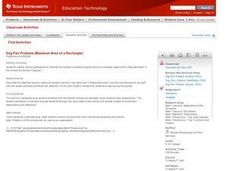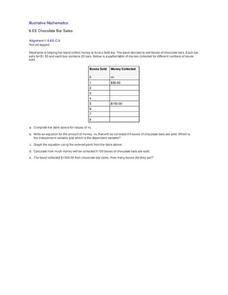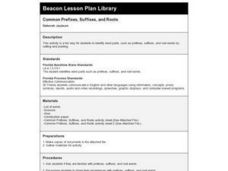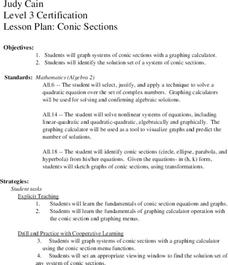National Endowment for the Humanities
The 1828 Campaign of Andrew Jackson: Changes in Voting Participation
Students give examples to indicate how voting participation changed in the first half of the 19th century, and make connections between changes in voting participation and the results of the election of 1828.
National Endowment for the Humanities
The 1828 Campaign of Andrew Jackson: Expansion of the Voting Base
Students give examples to indicate how the franchise was extended and limited in the first half of the 19th century, and cite some differences in the newly enfranchised population that could affect the way they would vote.
Curated OER
Dog Pen Problem
Teach your class about various approaches to solving the problem of maximizing the area of a rectangle space with a fixed perimeter in the context of a farmer's dog pen. Then, they complete a worksheet independently to summarize the...
Curated OER
How To Write a Social Studies Outline
One of the keys to success in school is organization. This resource leads learners through the process of creating an outline for a chapter from a social studies text. In addition, they review facts they have learned in their class...
American Statistical Association
Armspans
Young mathematicians collect data on the arm spans of classmates. Then they sort the data by measures of center, spread, and standard deviation. Finally, they compare groups, such as boys and girls, to interpret any differences.
Illustrative Mathematics
Chocolate Bar Sales
In this real-world example, algebra learners start to get a sense of how to represent the relationship between two variables in different ways. They start by looking at a partial table of values that define a linear relationship. They...
Illustrative Mathematics
Jayden’s Snacks
A quick activity to test the knowledge of your learners on adding and subtracting with decimals. They must calculate how much Jayden spent at the store and how much money he has remaining.
Illustrative Mathematics
Two-School Dance
Who's ready for the dance? When two middle schools combine for a dance, your learners' job is to calculate the ratio of girls attending. Provided with three different solutions, you can choose from setting up a ratio, linear equation, or...
University of Wisconsin
BEAM: Background, Exhibit, Argument, Method
Thinking of assigning a research paper? Get writers off on the right foot with a lesson that introduces the BEAM research model. Writers brainstorm the background of their topic, explicate the aspects of their topic, consider the...
Science Matters
Plot Study
Small groups investigate plots of land to discover how abiotic and biotic factors interact. After recording their findings, scholars share observations with peers and self-reflect on the learning process.
Curated OER
Death Egyptian Style
Students explore Egyptian burial, mummification and ceremonies. They create a mummy. Students role play the "Weighing of the Heart" ceremony. Students take a video quiz. They create a paragraph describing your afterlife if grave robbers...
Curated OER
Conservation Connection
Students work in groups to create a script for a one minute commercial on how to conserve our reusable energy sources. When the scripts are written, explain to the students that a story board is similar to a cartoon.
Curated OER
The Media and You
Seventh graders discuss the main purposes of media. Using various advertisements, they identify the method used by the advertisers in each example. They use these methods to create and sell their own product to the class. They use the...
Curated OER
Common Prefixes, Suffixes, and Roots
Sixth graders identify word parts, such as prefixes, suffixes, and root words by cutting and pasting. After a lecture/demo, 6th graders utilize worksheets imbedded in this plan to gain practice working with these parts of speech.
Curated OER
Science Talk about Mammals and Reptiles/Amphibians
Third graders use the internet to research mammals, reptiles and amphibians. They list important items about their chosen animal. Students identify characteristics of an animal and where they live. They classify animals as a mammal,...
Curated OER
HIV/AIDS, iChat, and the Immune System
Students study HIV and model the course of an infection. In this immune system lesson students examine HIV and AIDS and learn that it is a preventable disease.
Curated OER
Photodocumentation: Promoting Environmental Education Through the Development of Visual Literacy Skills
Students construct a photo document on their selected topic and use at least twelve photographs in their photo document. One must be of the authors. Additionally, they must write five interactive questions which help viewers interpret...
Curated OER
If My Configurations are Correct
Students write the electron configuration of elements in the ground state. For this chemistry lesson, students draw how subatomic particles are arranged in the atom. They construct Lewis dot diagrams of valence electrons.
Curated OER
Can You Hear Me Now?
Learners demonstrate their ability to give and follow verbal directions. They explain steps to guide another student to reproduce a drawing, and evaluate their partner's articulation abilities.
Curated OER
Advanced Information Systems Database Access
Young scholars investigate the usage of databases. They design and create their own databases to hold information. They edit the file and sort/ index the new database. They also generate a detailed report of the data present.
Curated OER
History by Heroes
Students role play one of the Presidents between 1877 and today. Individually, they use the internet to research the President through official documents, political cartoons and various editorials. Throughout the year, they are asked to...
Curated OER
The Beat of Your Heart
Students explore different applications involving their own heart. In this illumination lesson students measure their fists and relate it to the dimensions of their hearts.
Curated OER
Microscopes: Is what you see, what you got?
Eighth graders identify the parts and functions of the microscope. In this biology lesson, 8th graders observe different samples under different types of microscopes. They compare and contrast the details they see.
Curated OER
Conic Sections
Students, while using a graphing calculator, graph systems of conic sections as well as identify their solutions. They complete various word problems dealing with conic sections with their calculators. In addition, students sketch graphs...























